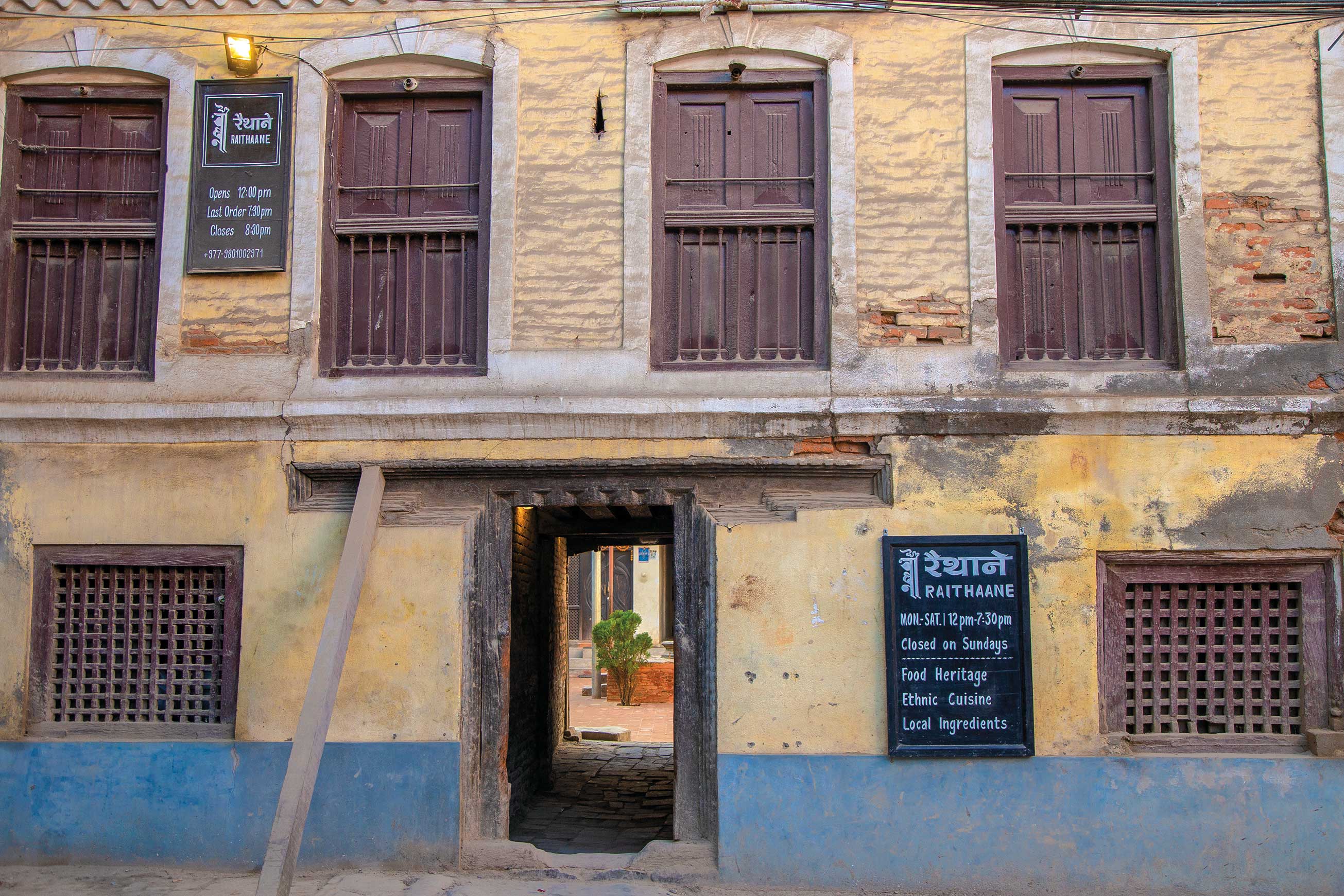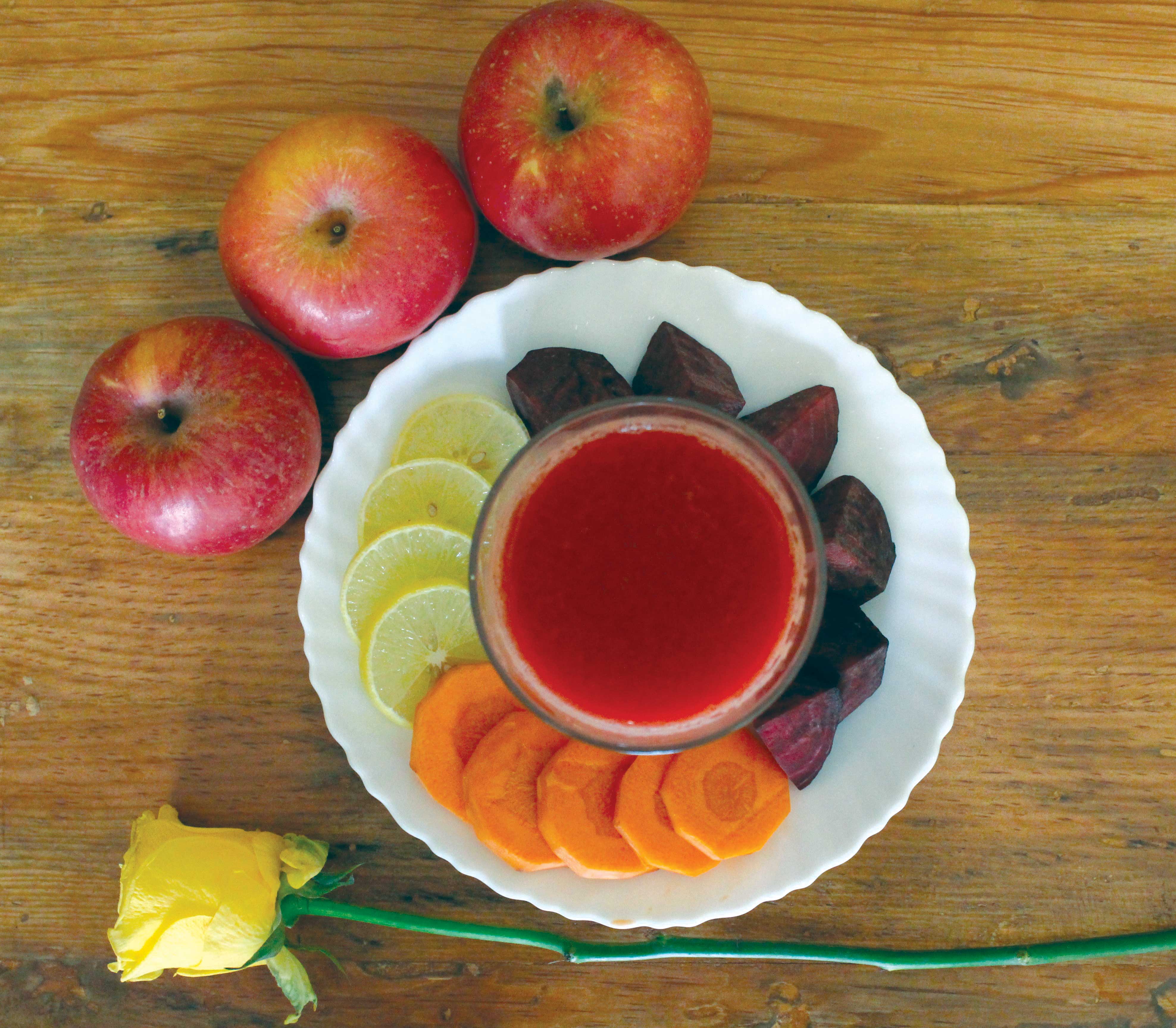“Bel pakyo kaglai harsha na bishmat” (The ripening of the bel fruit is no cause for a crow to be either happy or sad)” – so goes an old Nepali saying. It’s obviously referring to the fact that the outer shell of this fruit is too hard for a crow to peck into even with its hard bill. However, this unique Nepali fruit has become a source of good health and much wealth to many people nowadays. Of course, that is not to say that the many other delicious fruits of Nepal are playing second fiddle either.
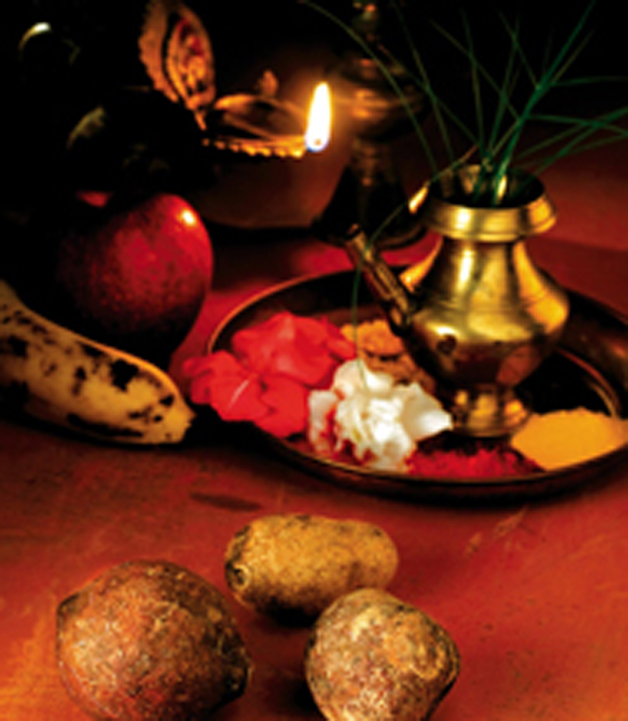
Fruits often have enormous religious significance in Nepal
Recently, I came across a beautiful passage on a blog wherein the writer waxes eloquent on the virtue of Nepal as a fruit lover’s paradise. Here is what he writes:
“Nepal is a paradise for fruits. First off, there are all the juice stands. Some are permanent, little kiosks with mounds of peeled fruit behind a glass counter. 50 rupees (less than a dollar) will buy you a big mug of juice squeezed fresh as you watch; orange juice and pineapple juice are popular, but my favorite breakfast drink is the local mix, which has a big scoop of pomegranate, a few oranges and mandarins, and a huge wedge of pineapple thrown in. It turns into a bright scarlet concoction with just the right sweetness and tanginess; sometimes I’ll drink two. No added sugar or syrup, like the horrific juice drinks back home; just pure goodness.”
Makes you want to rush out and have a tall mug yourself, doesn’t it?
But hold on and read what else this lyrical writer has to say, “Then there’s the real exciting stuff, the special Nepali fruits. Nepali bananas are the best in the world; they’re small and fat, and the skin is mottled so black and ugly you would think they’re totally rotten. But the flesh inside is so smooth it’s like custard; it melts in your mouth with a distinctive sweetness, unlike any banana back home. And at 2.5 rupees each, they’re practically free.”
Well, Patrick R (that’s the blogger’s name), no one else could have said it better than you. But Patrick, allow me to set the record straight here. Although you’ll find many varieties of fruits in Nepal, all are not grown here. In fact, here’s a headline from a daily dated 7/7/09, “Thailand Dominates Up-market Fruit Sales in Nepal”. According to this report, imported fruits ranging from guava to kiwi and red grapes to apricot are hitting Nepali fruits stores. Most of them are said to come from Thailand and some from China, Australia, India, Japan and Pakistan. Reportedly, Thailand supplies Bangkok guava, cherries, red grapes, kiwi, ram bhutan and red apple whereas fuji apple is imported from Australia. Sweet melon comes from India and Japanese melon is obviously imported from Japan. Mangoes come from both India and Pakistan. Of course, these fruits are quite expensive – for instance, Bangkok guava, a giant Thai variety, was selling for Rs. 500 per kg or Rs. 250 per piece. Compare that to local guava at Rs. 40 to Rs. 50 per kg.
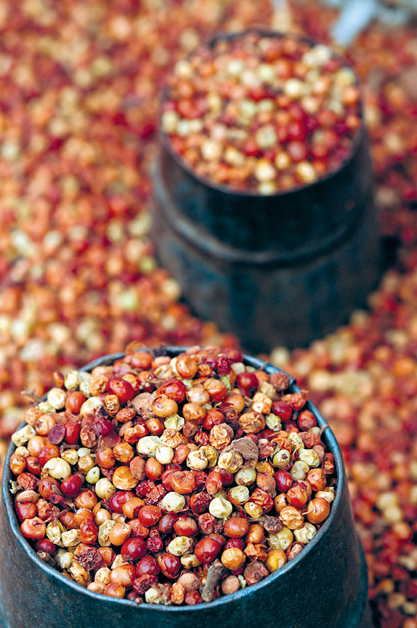
Sold by the tin cup, these berries are a local favourite
UNIQUE NEPALI FRUITS
Nepal does produce quite a number of fruits but two that are of special interest are the Lapsi (Choerospondias axillaris) and Bel (Aegle marmelos), which are unique to the country. Lapsi has a soft whitish sour pulpy flesh and green to yellow skin and they are made into pickles, fruit tarts, and sour, spicy candy. The candy is very popular while the pickle is really tasty and something Nepali housewives take great delight in making at home and storing in airtight bottles for consumption all year round. Lapsi is available in the market between the months of October and January and this is the time when one will get to taste freshly prepared
lapsi pickle in many a Nepali home. Taken warm and newly prepared, the taste will linger on in your mouth for a long, long, time. Besides the above, there is also a unique way of processing lapsi fruits in Nepal whereby dried lapsi strips prepared from pulp, and ripened raw fruit peels, are converted into sweet and sour tasty items called ‘mada’.
As for the bel fruit, they grow wild in the Terai forests. It is also known as wood apple, elephant apple and monkey fruit. Elephant apple, because elephants just love this fruit! The fruit has a gray or yellow rind and the pulp is orange-colored, sweet, and thick. The fruit is eaten in two ways, fresh or dried. In the first case, the juice is strained to make a lemonade-like drink and sugar is added as per need. When the pulp is mixed with lime juice, it goes to make a refreshing sherbet. As for the dried fruit, they are sliced and left to dry in the sun. Then the hardened slices are put into a pan of boiling water and left to simmer down. The leaves and small shoots are eaten as salad greens. The bel fruit has been used in ayurvedic medicine for centuries and is believed to be good for the digestive system, the heart and memory as well as for relieving dryness of the eyes and common cold. It is also claimed to cure chronic constipation.
Commercially, the bel fruit juice is bottled and marketed as Marmelous (the name derived from bel’s Latin name, Aegle marmelos) by some companies here. Kathmandu based Alternative Herbal Products is one such company and its Managing Director has said in an interview, “We used to see the forest littered with rotting bel and decided to turn it into an income-generating activity for the villagers.” Reportedly, his company has increased capacity to produce 70,000 bottles of bel concentrate a year. Just goes to prove its popularity. Indeed, Marmelous has many, many, admirers who drink it regularly for its marvelous health benefits. Marmelous - marvelous, got it?
In Hinduism, the bel tree is held to be sacred and many temples have one or more bel trees in their courtyards. The trident shaped leaves have always been a traditional offering to Shiva. It also plays an important part in Newari tradition. The Newars observe the symbolically arranged marriage of their daughters with a bel fruit (bel-bibah) when the girl is seven to nine years old (before she attains puberty). Her subsequent marriage is considered to be of secondary importance and even if she is divorced later on or her husband dies, she never really is unmarried or even, widowed.
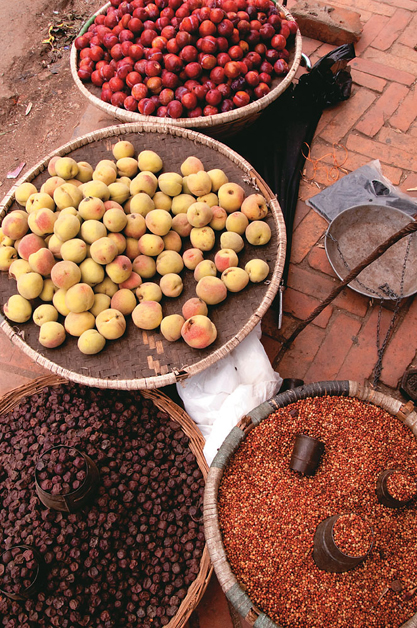
A colourful and nutritious assortment
AS FOR THE OTHERS
As for other fruits grown in Nepal, apple, peach, plum, pear, pomegranate, walnut, apricot, persimmon and almond are the country’s main winter fruits. Similarly, banana, guava, pineapple, lychee, mango, orange, sweet orange, papaya, jackfruit, lemon and coconut are the primary summer fruits. Mango, banana, guava and lychee are the four most important tropical fruits of Nepal. There are special efforts underway to make the highly fruitful business of fruit cultivation, a focal point of agriculture here. According to the Ministry of Agriculture and Cooperatives, total production of fruits and spices increased by 5.4% to 145,000 tons in 2007/08 as compared to
138,000 tons a year earlier. It has been a continuous effort going back four score years and more. The Department of Agriculture was established in 1925 and following this, mostly temperate fruits were introduced to Balaju and Godavari orchards in Kathmandu. A Horticulture Development Section was established in 1955 and several improved cultivars of Asian pear, peach, plum, persimmon, cherry and apple were introduced in Singh Durbar and Kakani farms. With substantial bilateral assistance from ICM and USAID, cultivar performance studies and propagation activities were done until 1963. During 1960 to 1973, six temperate horticultural stations with new cultivars of deciduous fruits were established at different locations of the country with support from the Indian Cooperation Mission (ICM). New temperate fruits and additional new cultivars were introduced and some horticultural stations were established during 1977 to 1980 under the Hill Agriculture Development Project assisted by FAO.
As mentioned before, although lapsi and bel are fruits unique to Nepal, many other fruits are also grown successfully in the country. To expand on this, here’s a list of the major fruits of Nepal:
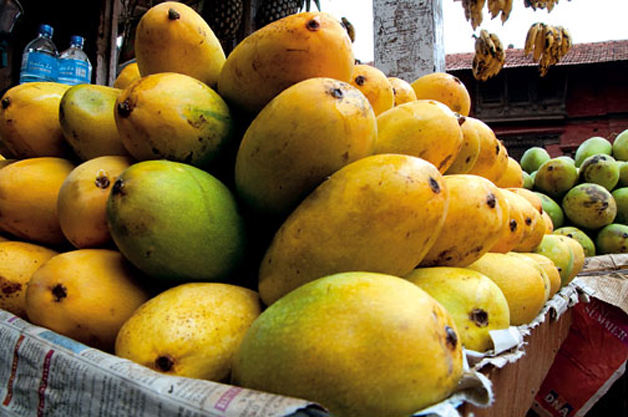
One of summer's best treats - luscious mangoes are as pleasing to the eyes as they are to the tongue
MANGO: It is grown in Siraha, Sarlahi, Mahottari, Sunsari, Dhanusha, Saptari, Kapilbastu, Jhapa, Bara and Morang districts, but production is insufficient and large quantities come from India. The usual types available here are Dashahara, Malda, Totapuri, Kalkatiya, Bijuri, Safeda and Alfanso, with Malda being the all time favorite.
GUAVA: It is grown widely all over the country and the fruit availability period is mainly restricted to four months, i.e. July/August and October/November.
LYCHEE: The Terai districts of the Central Developmental Region produce most of the country’s lychees, followed by Terai districts of the Eastern Development Region. There are two types of lychee cultivars in Nepal, namely the Terai and the Hill cultivars. The former consists of Mujafpuri, Raja Saheb, Deharaduni, China, and Calcutta varieties while the latter consists of Pokhara local, Udaipur local, Tanahu local, Chitwan local, Kalika local and Gorkha local.
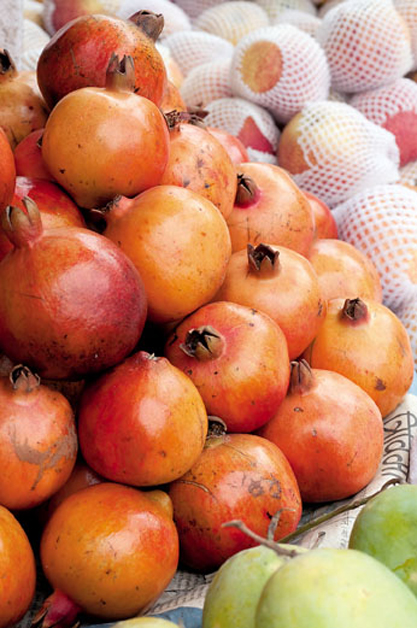 APPLE: For quality apple production, the most suitable areas are the inner Himalayan region of the mid and far Western regions where dry to semi humid conditions exist. Apple farming shows a successful trend and the luscious apples of Marpha in the Kali Gandaki Valley are particularly well known for their delicious taste. A wide variety of cultivars are grown in Nepal. They include, Red, Royal and Golden Delicious, Mcintosh, Jonathan, Rome Beauty, Granny Smith, Richared, Golden Spur, etc. The Delicious is the most popular. Katza, Red June, Cox Orange Pippin, Crispin, Summer Pippin. Anna, Vered, Tropical Beauty, Winter Banana, etc. are also cultivated.
APPLE: For quality apple production, the most suitable areas are the inner Himalayan region of the mid and far Western regions where dry to semi humid conditions exist. Apple farming shows a successful trend and the luscious apples of Marpha in the Kali Gandaki Valley are particularly well known for their delicious taste. A wide variety of cultivars are grown in Nepal. They include, Red, Royal and Golden Delicious, Mcintosh, Jonathan, Rome Beauty, Granny Smith, Richared, Golden Spur, etc. The Delicious is the most popular. Katza, Red June, Cox Orange Pippin, Crispin, Summer Pippin. Anna, Vered, Tropical Beauty, Winter Banana, etc. are also cultivated.
PEAR: It is cultivated in both mid and high mountain areas of the whole country. The oriental pear or sand pear, locally known as Naspati or Pharping Naspati (Pyrus pyrifolia), is very popular. Japanese cultivars including Shinsui, Shinko, Kosui, Hosui, Chojuro and Okusankichi were introduced into Nepal about 10 years ago under a Japanese Aid Horticulture project. European pears (P. communis) too were introduced into Nepal many years ago.
PEACH (ARU): It is grown extensively throughout the mid elevations between 1000m-2800m. About 44 improved cultivars of peach have been introduced into Nepal. These include Peregrine, Triumph, Elberta, Baby Gold, Suncrest, Rhodes, Red Haven, Florida Red, Orion, French Early, Cardinal, Armgold, Florida, Kuratake Wase, Texas, Spring Time, Early Red, J.H. Hale and Late Elberta.
PLUM: They are grown in areas where peaches are grown, except where there is early spring frost. European cultivars grown here are Green Gaga, Early Transparent Gage, Stanley, Ruth Gestetner etc. while the Japanese cultivars are Santa Rosa, Methley, Satsuma, Formosa, Mariposa, Burbank, Kelsey, Oishi Wase and Shiro.
APRICOT (Khurpani): Out of about 13 cultivars introduced into Nepal only a few have been successfully cultivated. These include Blenheim, Titon, Bulida, Rcale Dimola, Prete, Canino, Kaisa, Charmagz, Shakarpara, etc. Shakarpara is the most successful cultivar in Nepal.
NECTARINE (a form of Aru): Popular nectarine cultivars are Independent, Panamint, Arm King, Ruby Gold, Fantasy, Nectaret-2 and Neyorkert.
PERSIMMON (Halwabed): Grown in warm temperate areas throughout the country, the popular cultivars are Euyu, Ziro, Zenjimoru, Hiratanonashi, Hachiya and some local selections.
CHERRY: Cherries have a very short growing season and can grow in most temperate latitudes. The peak season for cherries is in summer. Cultivars grown are Napoleon, Satomishiki, Tokasago, Victoria and Bigara.
IN SUMMATION
Fruits are of course seasonal and here’s something on www.globalgourmet.com that says it better than I ever could:
“Citrus fruits arrive in the winter: orange (suntalaa) and grapefruit like pomelo, plus mushy Indian apples. Spring brings luscious tropical fruits like mangoes (aap) with their sweet, sticky, bright orange flesh. The fruit of the milder-flavored papaya (mewa) is the color of orange sherbet; its black seeds are said to be a sovereign remedy for upset stomach. The addictive litchi (lychee) appears in grape-like bunches in May-June: peel off the corrugated red skin to reveal the sweet white fruit, but beware of the large seeds.
August-Sept. brings yellow-skinned guavas (ambaa), with their edible seeds and soft flesh, and more Vitamin C than oranges. The brown naspati appearing in the fall combines the flavor and color of a pear with the texture and shape of an apple. Bananas (keraa) are available year-round in at least seven varieties; unlike other fruit, sold by the kilo, these are sold by the dozen.”
So, all in all, winter, spring, summer or autumn, Nepal is never short of delicious fruits to please the palate of most fruit lovers. The variety is wide and some of the fruits are pretty exotic as observed by our lyrical blogger Patrick R:
“Bimos (bimiras) are a strange citrus, in the shape of a large deformed orange. The pith is huge - you have to cut through 2 inches of it to get to the edible flesh underneath, but it has the oddest flavor of sour orange, almost grapefruit like. Best of all are palmellos, which I just discovered today. They’re huge tear-drop shaped citrus fruit with yellow-green skin, larger even than a grapefruit. They have an inch-thick pith, but the reward underneath is incredible. The flesh is scarlet red, crunchy like an apple, but with the sweetness of oranges and pomegranates and the sourness of grapefruit, but none of the bitterness.
They grow wild all over the country - all along the Bhote Kosi valley you can see trees weighed down with their heavy fruit. Apparently they’re festival food - trucks of them are being delivered all across Kathmandu in preparation for Tihar later this week. It’s going to be a tasty holiday.” I think Patrick is describing the ladies’ favorite known as ‘bhogate’ right? This fruit has an extensive role to play during the great Hindu festivals of Dashain and Tihar. After the (exhausting) festivities are over, women folk often get together just to have a ‘bhogate’ feast wherein the large fruits are mixed with salt and chili powder and a couple of other spices that goes to the making of a tasty salad like dish.
References: http://patrick8448.blogspot.com/2007/11/nepali-fruit.html
www.fao.org
www.globalgourmet.com


